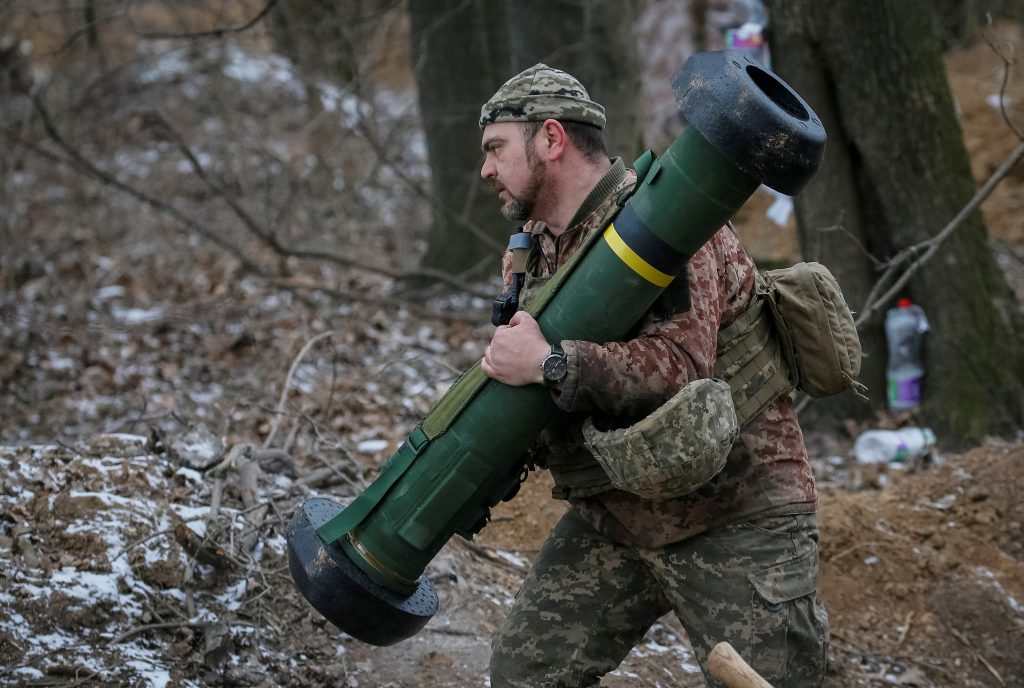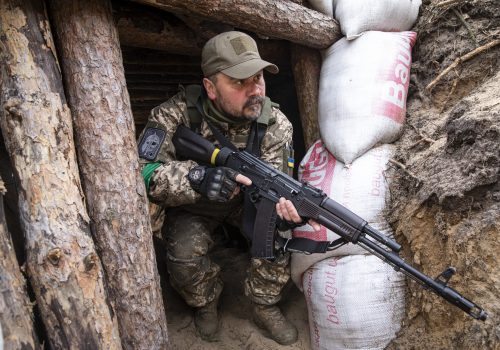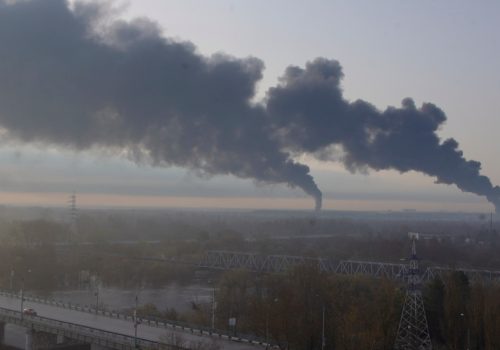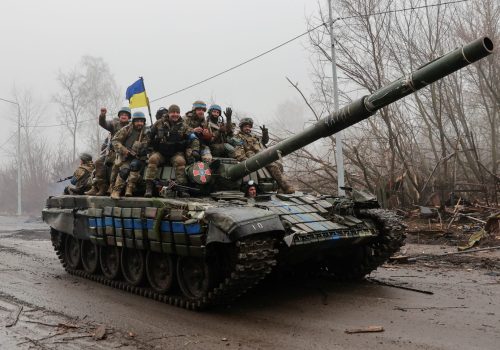In light of the ongoing Russia crisis, the Scowcroft Center’s Forward Defense (FD) practice will share regular assessments of the latest force developments surrounding Ukraine, leveraging the expert perspectives of our senior military fellows. The opinions, conclusions, and recommendations expressed or implied here are solely those of the authors and do not represent the views of the Department of Defense or any other US government agency.
The bottom line
- Russia has launched its offensive to take control of the entire Donbas region and expel or encircle and destroy Ukrainian forces there.
- The offensive is part of a larger Russian strategy to complete a land bridge from the Donbas to Crimea and, apparently, extending to the Transnistria region in Moldova.
- But one week into the offensive, Russian gains have been minimal, as Ukrainian forces have executed small counter-offensives, and this phase of the conflict is likely to devolve into a bloody war of attrition along established lines of control.
- We assess that victory in the Donbas region will go to whichever side seizes the advantage in offensive fires and resupply efforts over the next few weeks and months.
- The United States and its allies and partners have announced the transfer of heavy offensive weapons to Ukraine, potentially bolstering Ukraine’s ability to withstand and counter Russia’s superiority in numerical fires.
- The United States and its Western partners need to develop a plan for sustained security assistance to Ukraine, including the transfer and associated training of Ukrainian forces on advanced weaponry.
Moscow’s latest moves
On April 19, Russia initiated its campaign in the Donbas region with a large-scale artillery barrage in the Donetsk and Luhansk oblasts. Russian forces are now attacking Ukrainian forces in the western Donbas from all sides in an attempt to encircle and force the surrender of tens of thousands of Ukrainian troops. This campaign is likely to become a bloody stalemate, with Russia leveraging its numerical advantage in forces and long-range fires—including air and missile strikes—and artillery and rocket attacks to make small gains across the region.
On April 21, Russian President Vladimir Putin declared victory in Mariupol and directed Defense Minister Sergei Shoigu to halt the assault on the Azovstal steel mill and continue the blockade of the mill “so that a fly can’t get through.” We believe this decision was likely driven by high Russian losses and the desire to pivot Russian forces to the Donbas front.
That same day, Major General Rustam Minnekayev, deputy commander of Russia’s Central Military District, captured global headlines when he indicated that his country intended to take “full control” of much of eastern and southern Ukraine, including building a land bridge to Moldova’s breakaway region of Transnistria. Central to this objective would be taking the coastal city of Odesa—leading us to believe that Russia is likely to increase naval fires and missile attacks on Odesa, but will not be able to conduct an amphibious operation or an overland attack to capture it. It is highly unlikely that Russia will open up another major front while it focuses on the Donbas.
Subscribe to our weekly military assessment
Sign up for updates from Forward Defense to hear the latest on the trends, technologies, and military challenges shaping tomorrow.
The race to resupply
As the Donbas campaign grinds to a bloody stalemate, both sides will be desperate to maintain their logistics lines and resupply their forces. The delivery of reinforcements, ammunition, fuel, and supplies will be critical—and the side that establishes resilient supply lines first will gain a major advantage.
- Russian attacks on Ukrainian railways. On April 25, Russia reportedly attacked five Ukrainian railways in southern and western Ukraine within an hour of each other. While the United States and its allies and partners have remained silent on how their security assistance and military equipment is reaching Ukrainian forces, some—if not most—large deliveries likely rely on rail transport to reach the Donbas. We believe that a coordinated Russian attack on Ukrainian rail lines is designed to slow the supply of equipment and needed supplies to Ukrainian forces there. Russian forces likely used precision-guided munitions from air and missile strikes to target the rail facilities. The Kremlin is likely to continue this tactic.
- Likely Ukrainian attacks on fuel depots. On the morning of April 25, two large fires broke out at fuel depot facilities in Bryansk, Russia, approximately one hundred miles from the Ukrainian border. The Ukrainian military has not yet claimed credit, but we assess that the fires were most likely started by a Ukrainian air or missile attack, not a Russian-staged false flag operation. Though the Kremlin has pushed multiple narratives to justify its aggression, it would be illogical to harm its own critical fuel supplies. The Ukrainians could have used multiple methods to execute the strike, including a special operations mission; an air attack from a ground-attack fighter, helicopter, or unmanned aerial vehicle (UAV); or a surface-to-surface missile attack. Most likely, the Ukrainians conducted a missile attack via the Tochka-U tactical ballistic missile or the TB-2 Bayraktar UAV, as both have the range to reach the target and the precision to execute the attack, while presenting limited risk to Ukrainian forces and equipment. The fuel fires—coupled with a Ukrainian helicopter attack on a fuel depot in Belgorod on April 1 and numerous other attacks on Russian supply lines—are likely part of a Ukrainian strategy to target critical logistics lines and supplies, starving Russian military forces of needed fuel and munitions.
- Winning the resupply race. Russia has numerical superiority in the Donbas, as well as a comparative advantage in air- and ground-launched fires. In a drawn-out war of attrition, we assess that this advantage will gradually tilt the battle toward Russian forces—that is, unless Ukraine can develop and protect redundant supply lines and deny Russia the ability to secure its own. The better-supplied force will be able to sustain pressure on enemy lines, building offensive momentum and increasing the chance of a victory in the Donbas.
- Sinking of the Moskva. On April 14, the Slava-class guided-missile cruiser Moskva—the flagship of the Russian Navy’s Black Sea Fleet—sank. The cause and total Russian casualties remain in dispute. While Russia dubiously claims the ship was lost to fire and stormy seas, the US Department of Defense (DoD) has confirmed Ukraine’s claims that its forces hit the ship with two locally developed Neptune anti-ship missiles. It is unclear how many operational Neptune missiles Ukraine has, but the loss of the Moskva underscores the importance of anti-ship capabilities, especially if Russia attacks Odesa. Resupplying Ukraine with anti-ship missiles will be critical to keeping pressure on the Russian Navy.
- The long game. In order to deter future invasions, Ukraine should consider withdrawing from the Ottawa Treaty—which bans the use of anti-personnel mines—and defending its frontier with Russia with a fenced and clearly marked minefield like the one along the DMZ in South Korea. However, while the treaty prohibits the use of anti-personnel mines, it does not address anti-tank mines, including man-in-the-loop remote controlled mines, such as the claymores the United States has provided Ukraine. In addition to withdrawing from the Ottawa Treaty, Ukraine should invest in smart naval mines as part of an asymmetrical defense countering Russian naval superiority in the Black Sea.
Keeping the security assistance coming
The newest tranche of US military assistance. On April 21, US President Joe Biden announced an additional $800 million of security assistance to Ukraine. Highlights from the latest announcement include: seventy-two 155mm Howitzer towed artillery pieces, 144,000 artillery rounds, and 121 Phoenix Ghost tactical unmanned aerial systems (similar to the Switchblade “kamikaze” drone). This tranche focused on the type of offensive weapons (i.e., long-range artillery and lethal drones) that Ukrainian forces need to win in the Donbas.
Security assistance for Soviet-built systems. On April 25, the DoD announced another $165 million in security assistance to Ukraine, bringing total US security assistance to nearly $3.6 billion since the invasion began. Unlike previous transfers of military equipment, this aid is exclusively for the procurement of Soviet-built equipment and ammunition for systems the Ukrainians already operate—specifically rockets, artillery shells, and mortar rounds. This aid is critical because it will be easier to move to the front than entire Howitzer systems, no training or integration testing is needed, and these munitions can make an immediate impact on the battlefield.
Need for sustained military assistance. Throughout the conflict, US government officials and national-security experts have held off on transferring “heavy weapons” with long training timelines and integration processes, including US-built fighters, air defense systems, and multiple launch rocket systems (MLRS). Because Ukraine needs immediate help, the logic went, these systems would not impact the short-term objective of keeping Ukraine in the fight. While valid at the time, this reasoning does not hold as the war drags on. The United States and its allies and partners must shift their overarching objective from simply keeping Ukraine in the fight to building a strong military machine that can decisively defeat Russian forces.
- United States already training Ukrainian forces. On April 20, DoD announced Ukrainian forces had begun training on the 155mm Howitzer. This came just two weeks after DoD announced it was training Ukrainian operators on the Switchblade drone. The moves undercut arguments against the transfer of equipment with long training timelines.
- What advanced weapons does Ukraine need? While Ukrainian forces are optimizing the use of aging, Soviet-built equipment, their stocks of weapons systems, ammunition, and spare parts are rapidly depleting—even with the addition of ammunition and spares from the former Warsaw Pact nations now in NATO. We assess that Ukraine needs advanced fighter aircraft such as the F-16 Fighting Falcon; modern short- and medium-range air defense systems similar to the Iron Dome and surface-launched advanced medium-range air-to-air missile (SLAMRAAM); precision MLRS such as the High Mobility Artillery Rocket Systems (HIMARS); and long-range anti-ship missiles such as the Norwegian Naval Strike Missile (NSM) or the coastal defense variant of the Harpoon. Each of these systems requires a significant investment of time and resources for training and integration. However, these advanced weapons could provide the capabilities Ukraine needs to win (and end) the war rather than merely stay in the game.
Defense Production Act (DPA). The US transfer of weapons to Ukraine, especially Javelins and Stingers, has increased dramatically since the war began. The DPA could provide tools to help the United States sustain the flow of weapons to Ukraine while also replenishing its own stockpiles. Many presidents have used the DPA to direct private companies to prioritize government orders; provide loans; and allocate materials, services, and facilities for national defense purposes. Deputy Defense Secretary Kathleen Hicks met this month with many of the largest defense contractors to discuss equipping Ukraine and backfilling stockpiles. Part of the power of the DPA is the understanding among contractors that the US government can direct action if needed.
- Javelins. So far, the United States has provided seven thousand Javelins to Ukraine (approximately one-third of the US stockpile). The Army had planned to procure about one thousand per year through 2025, but the war in Ukraine has accelerated those acquisition plans. The wait for new Javelins is currently about thirty-two months from the order date. While contractors may have enough financial incentives to increase production capacity and shorten delivery timelines on their own, DoD may need to consider use of the DPA to accelerate acquisition.
- Stinger missiles. Analysts estimate that the United States has sent about one-quarter of its stockpile of Stinger missiles to Ukraine, and the CEO of Raytheon told investors on April 26 that he wouldn’t be able to ramp up production until next year, due to parts shortages. The Stinger is 1970s-era technology, and the United States is shifting acquisition strategy toward a weapon with new capability. However, DoD knows it still needs to meet the demands for the Ukraine war, so it is plausible that the Pentagon will take a dual track and expedite procurement of both systems.
- 155mm Howitzers. The United States’ recent commitment of 90 towed 155mm Howitzers and 183,000 rounds is significant. DoD did not specify whether it was supplying the newer M777 model or the older M198 model. The M777 is lighter weight and has electronic fire control that allows for quicker fire missions, but the M198 would more easily keep the Ukrainian Army supplied with spare parts and replacement systems (due to the amount of excess in US inventory). The M777 offers some tactical advantages, but it may also require DoD to expedite contracts to fully sustain the Ukrainian Army.
FD’s conclusion
We predict that the battle for the Donbas will be won by the same side that wins the race to resupply. Both Russia and Ukraine recognize the importance of logistics, as seen by recent attacks on enemy resupply lines. Despite huge losses in the north, Russia maintains numerical and firepower superiority. Ukrainian forces must continue to outthink their adversary—but they must also be supplied with the offensive weapons to counterattack and dislodge Russian forces from entrenched lines. As the war drags on, the United States and its Western partners must realize the value in sending Ukraine advanced Western weaponry. This strategy will not only keep Ukraine in the fight but give Ukraine a real chance of victory.
Check out these military moves and more on our military assessment map here.
Meet the FD team
Today’s briefing is brought to you by senior US Air Force fellow Lt Col Tyson Wetzel, senior US Army fellow COL Benjamin G. Johnson, and senior US Marine Corps fellow Col J.B. Barranco. The Scowcroft Center Military Fellows Program, housed by the Forward Defense practice, hosts military fellows from participating branches of the US military and the armed forces of US allies and partners each year as part of a twelve-month fellowship program.
Further reading
Wed, Apr 13, 2022
Russia Crisis Military Assessment: How Ukraine can take the fight to Russia
New Atlanticist By
As Ukraine prepares for a larger fight against Russian forces in the east, its military is in urgent need of weapons that will support an offensive, according to our military fellows.
Tue, Apr 26, 2022
Russian War Report: Geolocating fires in Bryansk
New Atlanticist By
On April 25, large fires were reported in Bryansk, Russia, just 100 kilometers from the Ukrainian border. DFRLab geolocated the fires to confirm an armed forces fuel depot was damaged.
Sat, Apr 9, 2022
Lend-Lease for Ukraine: US revives WWII anti-Hitler policy to defeat Putin
UkraineAlert By
The United States is reviving the WWII Lend-Lease program which helped defeat Hitler in order to dramatically increase arms deliveries to Ukraine and set the stage for Vladimir Putin's eventual military defeat.
Image: A Ukrainian service member holds a Javelin missile system at a position on the front line in the north Kyiv region, Ukraine on March 13, 2022. Photo by Gleb Garanich/Reuters



